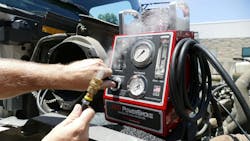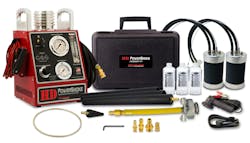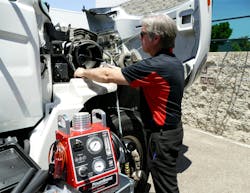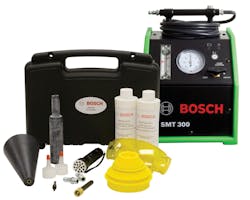Vehicle system leaks can be among the more time-consuming issues to resolve. Leaks are often difficult to pinpoint, leading to technicians spending a lot more time on diagnostics versus making actual repairs. Your operation may also incur more costs if techs start needlessly replacing various components to resolve phantom issues. Fortunately, smoke machines can help remove the haze associated with leak detection, a reason they often become one of the more indispensable tools in fleet maintenance shops.
“A diagnostic smoke machine is a valuable general repair tool that can quickly diagnose issues in both low-pressure, traditionally aspirated vehicles, and also large, heavy-duty, turbo-boosted, and diesel trucks,” said Alex Parker, president of Redline Detection, a manufacturer of diagnostic leak detection equipment.
How do they work?
“A test typically takes under 10 minutes from setup to confirmed diagnosis, producing fast and accurate results,” she explained.
And this can help shops from leaking money on unproductive labor time. Considering how technician pay continues to rise, these machines’ relative low cost (often $500 to $1,500), and durability provide a tangible ROI for many years.
“A high-quality smoke machine is considered a lifetime tool that will pay for itself in weeks based on serviceability,” Parker said.
“As long as you can inject smoke into a system and cap off the opposite end, you can use a smoke machine to find a leak,” said Jeff Wiedecke, VP of sales at Mastercool, a manufacturer of leak detection equipment and other vehicle and HVAC service tools.
When it comes to operation, some smoke machines are easier to use than others, and some vehicle systems are easier to test than others. That said, Wiedecke believes the learning curve is relatively short for the typical vehicle technician.
In the case of an exhaust leak, for example, a technician would insert either a bladder or cone into the exhaust pipe. If working on something like a semi-truck, they’d use a large, specialized bladder to insert into the stack. Once the end of the system is capped off, the technician utilizes the smoke machine to inject pressurized smoke into the system.
“The technician introduces smoke vapor into the system they’re testing and uses a light to locate a potential leak,” said Duane “Doc” Watson, technical trainer at Bosch Mobility Aftermarket, a provider of diagnostic and shop equipment, as well as replacement parts. “If the technician sees smoke coming out of the system, there is a leak.”
Along with knowing how to properly cap off a vehicle system, the technician must also know how to set the pressure on the smoke machine itself. Some have an internal compressor, while others utilize shop air. An internal regulator allows the technician to set the psi to whatever they need. Large systems like exhaust or intake require at least 10 psi. Smaller systems often require less, but large trucks can require much more. “However, most vehicle systems are not designed to handle 90 psi like shop air generates,” Wiedecke pointed out. That’s why the regulator is so important.
Once the pressure is set, Wiedecke advises technicians to first run the smoke machine without even injecting smoke. That pressurizes the system being tested. Dials on the smoke machine show how much pressure is being injected into the system. After about five minutes, the technician can see if the system is maintaining the desired pressure level.
“If it holds that preset psi, the technician knows there isn’t a leak, so there’s no need to bother adding smoke,” Wiedecke explained. “But if it doesn’t hold the pressure level, the technician can now add smoke to determine where the leak actually exists.”
The smoke is produced via a mineral oil that goes through a heating element, and is then pushed into the system under pressure. “Keeping it under pressure is the key because that is what forces the smoke out of the leak, wherever the leak might be,” Wiedecke said.
To provide an additional visual cue, some smoke machines allow for the use of dye. This allows the technician to utilize a UV light to search for the leak, with the assumption being that even a tiny leak will be easy to see. But as Wiedecke pointed out, every smoke machine comes with a high-powered, telescoping flashlight so the technician can direct the beam into the tightest of areas to look for locations where smoke is coming out—even if that smoke is in its natural white state. Many technicians find this approach to be more than sufficient.
“One thing to think about when using a dye is that it can cause issues down the road,” Wiedecke added.
Any residue from a previous test could show up under a UV light and give a false indication of another leak in that location. The dye has to be cleaned up thoroughly after a test is completed, which requires more time on the part of the technician.
Types of machines and uses
According to Redline’s Parker, it’s an industry standard practice to use smoke machines for diagnosing a range of issues, including:
- Turbo/boost
- Engine check light issues related to the aftertreatment system
- Overly frequent regeneration
- Limp mode
The aftertreatment system can be one of the biggest beneficiaries of smoke machine diagnostics.
“The use of a high-pressure smoke machine is a recommended practice by the Technology & Maintenance Council of the American Trucking Associations,” Parker pointed out. “Pinpointing upstream, unmetered air leaks in heavy-duty systems cuts down on premature clogging of DPF filters, and can mean less maintenance and lower maintenance costs.”
According to Parker, the most frequently found heavy-duty component leaks are:
- Clamps and tubing to/from the charge air cooler
- Charge air cooler itself
- V-clamps, gaskets, and exhaust tubing cracks on the DOC/SCR
- Turbo housing leaks
- DPF gaskets and housing failure
To diagnose those and many other leak-related issues, there are three general types of smoke machines.
EVAP (evaporative emissions) machines are low-pressure systems set at just 0.5 psi because they work with a vehicle’s fuel system. Wiedecke said they can also be used to check for vacuum leaks which cause high or low idling and knocking.
High-pressure smoke machines allow technicians to look for things like exhaust, intake, and turbocharger leaks.
Heavy-duty smoke machines allow technicians to check for everything, Wiedecke pointed out, including large-system leak detection on large trucks. Unique accessories often accompany these machines so technicians can properly cap off large systems like exhaust stacks on semi-trucks. Technicians can also check air brake systems, as well as oxygen, temperature, and pressure sensors found on semi-trucks.
Justifying the investment
Regardless of which type of smoke machine a shop ends up using, saving time is the biggest reason why an investment will likely pay dividends.
According to Bosch’s Watson, ROI ties to one major factor: accuracy.
“Tracking the number of comebacks can help a shop evaluate the ROI for their smoke machine. All in all, it’s an investment that can lead to multiple benefits across the shop floor,” Watson said.
Penske Truck Leasing has been using smoke machines for seven years. Adam Sands, director of tool management optimization, said they currently use the Bosch HPT 500 high-pressure leak tester, which is actually manufactured by Redline Detection.
“The high-pressure leak tester is essential in diagnosing difficult emission-related faults,” Sands said. “We have found leaks in many components on medium- and heavy-duty engines, like the charge air cooler, intake air system, exhaust manifolds, cracked exhaust bellows, exhaust gas recirculation (EGR) piping, cracked aftertreatment systems, and misaligned diesel particulate filters (DPF). Also, it is often used to find water leaks in truck cabs and cargo boxes.”
According to Sands, any technician with a basic knowledge of safety precautions can effectively use a high-pressure leak tester. Training starts with studying the operator’s manual. Use of the smoke machine is also covered in Penske’s exhaust stream management training class and related in-house training videos.
The relatively short technician learning curve is one of several factors that play into ROI for Penske Truck Leasing.
“A smoke machine truly makes it easier for a technician to execute a core function of their job safely, efficiently, and accurately,” Sands said. “This turns into less time to diagnose, repair, and validate leaks that one cannot normally find with ease. When a technician can be reassured with training and proper use of an accurate, high-quality tool, they are confident, and it builds trust with the customer that it’s going to be done right the first time.”
A fleet maintenance shop should choose a smoke machine that aligns with the type of vehicles it services. For a shop working on a variety of truck classes, Wiedecke said a smoke machine with a high degree of functionality and versatility makes sense. For instance, Mastercool’s Model 43065 is a dual machine that’s high-pressure on one side and low-pressure EVAP on the other. Redline’s Dual Purpose Diagnostic Leak Detector also allows technicians to switch from low- to high-pressure testing. Various accessories and accessory kits then allow for large-system testing on large vehicles.
On the other hand, there are also smoke machines that are EVAP-only, as well as those designed exclusively for high-pressure systems, heavy-duty trucks, and even specific vehicle systems like cooling systems and air brakes. Again, a shop should assess the types of vehicles it is servicing and the services it is providing. As long as a smoke machine will see regular use, the investment will likely pay off.
Parker offered one final piece of advice. Narrow your choices down to smoke machines that are made in the U.S. Doing so will ensure the best quality, as well as easy domestic service and support, and the ability to refurbish and repair.
“With those considerations, you will have a lifetime tool,” Parker said.
About the Author

Gregg Wartgow
Gregg Wartgow is a freelancer who Fleet Maintenance has relied upon for many years, writing about virtually any trucking topic. He lives in Brodhead, Wisconsin.




